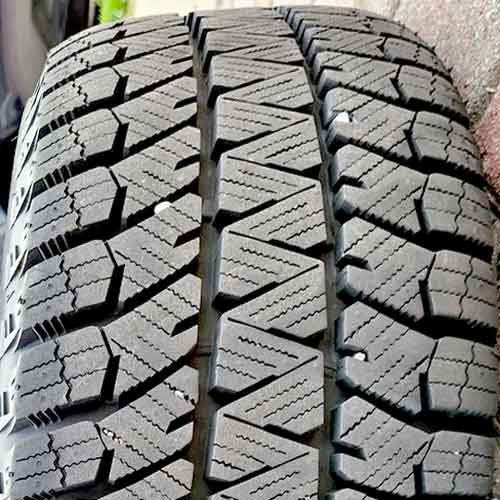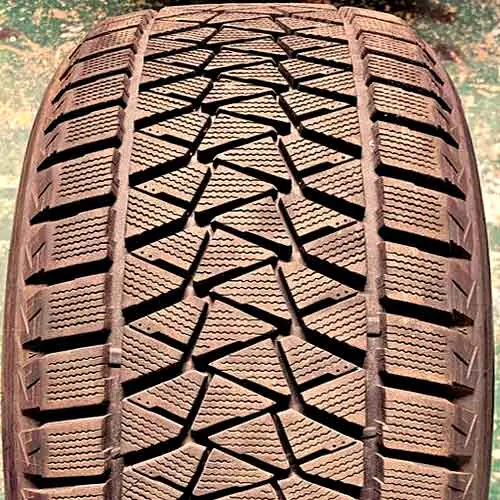Bringing together engineering excellence and innovation, both the Bridgestone Blizzak WS90 and the Blizzak DM V2, offer exceptional winter tire designs, to master the most challenging snow and icy conditions. But how well these tires do in other areas? Well let’s find out!

Table of Contents
Tire Sizes
The Bridgestone Blizzak WS90 (review) comes in 52 total sizes in 15 to 19 inches rims, with following specs.
- Speed ratings: T or H.
- Load ratings: SL or XL.
- Tread depth: 11 or 12/32″.
- Weight: 17 to 29 lbs.
On the other side, the Bridgestone Blizzak DM-V2 (review) comes in 15 to 22 inches with following.
- Speed ratings: R, S and T.
- Load ratings: SL and XL.
- Tread depth: 13 or 14/32″.
- Weight: 27 to 45 lbs.
Tread Appearance
The Bridgestone Blizzak WS90 captivates with its compelling and meticulously configured directional tread pattern.

The tread predominantly features three bold ribs, with the central one designed as a continuous unit.
Decorated with a host of wave-like sipes, the central rib also showcases linear, interconnected sipes which are integrated flawlessly with in-groove notches.
And these lateral grooves are then joined up with V shaped notches facing on both sides.
The shoulder lugs surpass typical design norms with notches, aimed towards the central rib, and additional biters on the sides, aligned with wide, angled longitudinal slits.
Further versatility in these shoulders is provided by zigzag-shaped slits on the lugs.
And yes, mirroring the central blocks, you also see similar wave like siping over here as well.
On the other hand, Bridgestone Blizzak DM-V2 comes with a very different and yet again unique tread pattern.

There are 3 ribs in the middle area of the tread, which is separated from the shoulder lug by wide prominent circumferential grooves.
All 3 ribs have triangular shaped blocks, though the central ones have slighter smoother edges compared to surrounding ones.
Nonetheless, they all carry aggressive wave-like siping, along with in-groove notches, joined up with rectilinear thick siping slits.
Moving towards shoulders, lugs are very blocky here, though they have off-set edges.
Moreover, they also have wider lateral groove in between.
And like the middle lugs, they also have similar siping.
Ice Performance
On icy roads, the Bridgestone Blizzak WS90 stands as the superior option when compared to its little brother.
The WS90 basically employs innovative design elements, such as specialized biters dispersed across the tread and fitted with V-shaped notches.
This unique construction, coupled with multiple siping angles, empowers the WS90 with superior braking and acceleration capabilities on icy tracks.
Furthermore, the tire’s comprehensive grip from all angles contributes significantly to its performance when handling or braking on icy terrains.
In contrast, the Blizzak DM-V2, although also features multiple biters, having a lot of angles to them as well, the tire still lacks, as those biting edges are relatively wider.
So it makes sense why Dm-v2 is designed for SUV and heavier vehicles. It’s wider tread voids, aren’t able to properly grip on the packed up icy surface, where tiny aggressive siping and narrower biting slits are needed.
Moreover, as you can see form its tread (scroll up), the tire is missing with any kind of notches on the shoulders, where you get multiple-angled ones on its counterpart.
So overall the Bridgestone Blizzak WS90 takes the lead when it comes to icy terrains.
Snow Performance
When the terrain shifts from ice to snow, however, the Blizzak DM-V2 clearly surpasses the WS90.
So why is that?
Well in case of fluffy snow, you need tires that are capable of making greater snow to snow contact. And with wider grooves, that happens more efficiently on DM V2.
The tire’s symmetric tread with numerous triangular shaped lugs featuring multiple in-groove notches holds on to the snow particles in a better way, creating a layer of captive snow, which connects with the ground to produce greater traction.
This happens because snow really likes to stick on other snowflakes, instead of rubber.
The Bridgestone Blizzak with its slightly more closed up pattern lacks in this regard, where its grooves aren’t able to accumulate as much snow.
Though in the tire’s defense, where you see a lot of margin in directional grip and acceleration, its very little in the handling department. In fact, subjectively it feels the same.
On snowy terrains, the Blizzak DM-V2 has the upper hand.
Wet Traction
Wet traction performance depends largely on two elements: the tread pattern and the rubber compound. These components significantly affect the tire’s ability to grip wet surfaces and resist hydroplaning. Let’s delve deeper into these elements.
Wet Grip
While both tire models feature ample siping and flexible tread rubber, the Bridgestone Blizzak WS90 still emerges superior in terms of grip.
Though to be more specific, you get a superior handling performance on this tire, and its a more overall dominating traction factor. But yes, you can say, both tires are almost equal in case of wet directional grip.
So why the handling then?
Well, because Blizzak WS90 features more effective water cleaning abilities from its shoulders, where you see multi angled sipes, along with notches facing both lateral and longitudinal directions.
This allows for grip in all directions as the tire corners, allowing for minimal slippage.
On the other hand, the Bridgestone Blizzak DM-V2 is equipped with only laterally oriented sipes on its shoulders, and so the tire gives out lacking overall handling times (on laps, during testing).
Hydroplaning
Hydroplaning happens when water hinders the tread from making proper contact with the ground (as thin layer of it forms in between), leading the tire to ‘float’, and resulting in complete loss of traction, which is a considerable safety issue.
In this regard, among the two tires, the Bridgestone Blizzak DM-V2 excels overall, with its broader grooves offering water dispersing in all directions.
Whereas in case of Blizzak WS90, you don’t get any interconnected lugs, so water is restricted more to move out, especially in the lateral direction (with the tire’s continuous running middle most layer).
So overall wet traction is better on WS90.
Dry Traction
Dry traction, a significant performance aspect of any tire, is influenced by the extent of rubber in contact with the road surface.
And here, two integral factors have to be considered, namely, directional grip and lateral traction. Let’s talk about them both one after another.
Directional Grip
The efficiency of the directional grip predominantly resides in the tread’s central area. This is because when rolling on highways (staright), most of the weight (the tire carries) is focused there.
That’s the reason why you see a better performance on the Bridgestone Blizzak WS90, with the tire’s continuous-running middle rib, making a more proper contact with the tar, and resulting with shorter braking efficacy.
In contrast, the Blizzak DM V2 lacks here, with not only its wider grooves, but also with its less overall streamlined structure.
So overall dry traction is better on Blizzak WS90.
Handling
The quality of handling is primarily dictated by the tire’s shoulders and overall weight. This is because during cornering, the weight, the tire carries is shifted/focused on to the edges of the tread (this is because of inertia).
And so here, the Blizzak WS90 is again taking the lead, mainly because of two things.
One, its shoulder blocks are more packed up, which allow for better rubber to road contact.
And two, the tire features lighter structure, combined with shallower tread depth.
Both of these features basically allow for smaller lug play (bending of the blocks, as the tire corners). And so you get a more balanced under and oversteering abilities.
The DM V2 on the other side, with wider grooves, and larger tread depth induces more lug movement during cornering, thereby reducing steering feedback.
So overall handling and braking efficacy is superior on Blizzak WS90.
Tread Life
Tread endurance is an aspect that’s heavily influenced by rolling resistance, and in this sphere, the Blizzak WS90 pulls ahead of the competition.
But before I explain the reasoning behind it, understand, that there is a difference between durability and treadwear. Both of them are different subjects, and one has nothing to do with the other, well for the most part.
Having said that, even though the Bridgestone Blizzak WS90 is a less durable tire off the two, it gives out superior tread life with its lighter weight emphasizing less pressure on its lugs, as the rub against the ground.
On the other hand, the DM-V2 wears down faster compared to its counterpart, with its larger weight pushing lugs to rub with greater friction, even though the tire features one of the largest tread depths in the winter (on-road) category.
Generally speaking, greater tread depth means more time to reach down to 2/32″, which is the legal limit with which you can drive in US, for example.
So anyways, with greater friction, it also means bigger rolling resistance value, and that also affects the fuel economy of the tire.
So in essence, you can say, that the Blizzak WS90 features better MPGs and overall tread life, even though both tires don’t come with any sort of warranty.
Comfort Levels
Riding comfort in a tire is predominantly determined by the degree of road noise it produces and its proficiency in dampening vibrations. These traits are shaped by the tire’s construction for the most part.
Let’s check them out one by one.
Tread Noise
Noise is produced when air particles collide with the walls of the tire tread. So you can say, the larger the tread voids, the more pronounced the noise.
Now lets see why comparing both tires, you see more quietness on Bridgestone WS90.
The tire for one features more closed up shoulder lugs, where most of the air enters, and in a similar manner, you also get crowded lug design in the middle, where the air particles have less room to move around.
So less noise gets generated in the first place.
Moreover, the remaining noise is further dampened down with tire’s superior pitch sequencing.
Both of these features are missing on its counterpart, so you get a quieter ride on WS90.
On-Road Vibration
The Blizzak DM-V2 may be louder, but the tire really does well when it comes to impact comfort.
This is because for one, its tread rubber is more absorbing to the bumps. And two, it features greater tread depth, so you get a larger rubber layer between you and the bumps.
So bumps absorption is better DM V2.
Summing Up
In snow-filled conditions, the Bridgestone Blizzak DM-V2excels due to its unique tread design and a larger number of tread voids, delivering superior snow grip and clearance.
However, on icy surfaces, the Bridgestone Blizzak WS90 outperforms its rival. This is thanks to its variety of intricate biting edges, slanted incisions, and multi-angled sipes, all of which enhance overall traction and handling.
Furthermore, the tire exhibits superior grip on both wet and dry surfaces, but the Bridgestone Blizzak DM-V2 excels in its hydroplaning resistance.
Taking all factors into account, the Blizzak WS90 slightly outperforms, thanks to its slightly superior fuel economy, longer tread life, and less noisy performance.